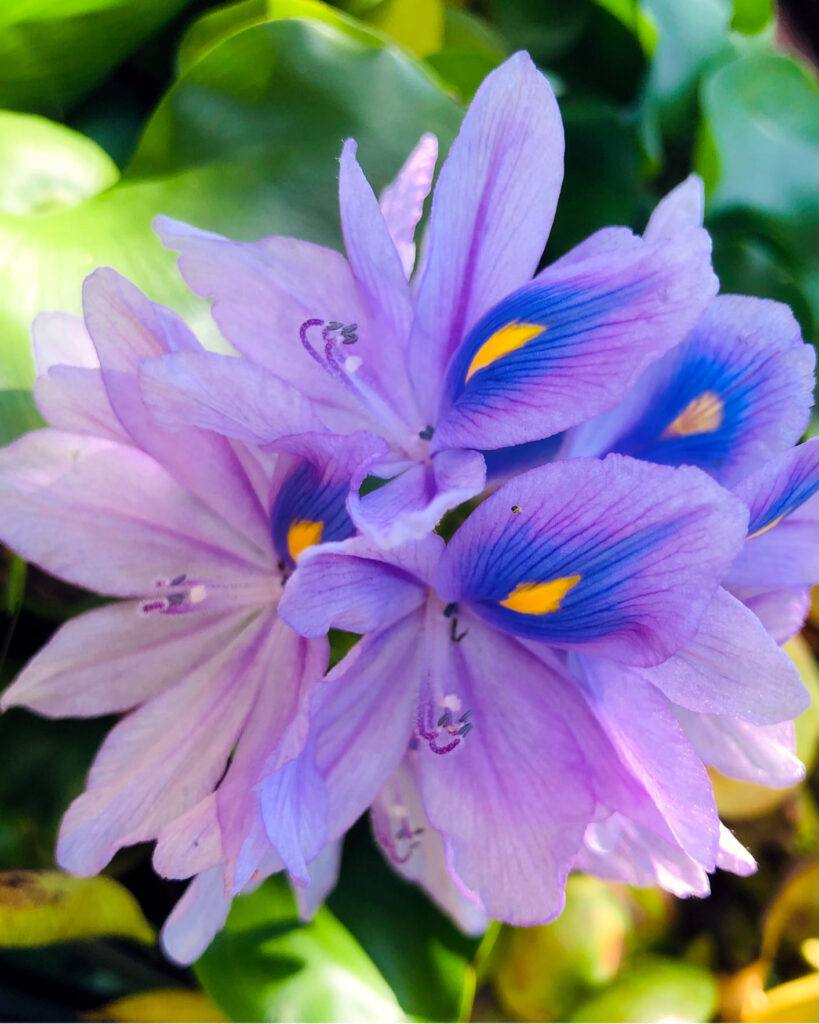
Because it blooms with flowers resembling hyacinths, in its native regions of North and South America, it is also called the “Water Hyacinth.” It is generally believed that it was introduced to Japan as an ornamental plant during the Meiji era. However, there is an 1855 work by the Edo-period artist Utagawa Kunisada depicting water hyacinths along with goldfish and beautiful women, suggesting it may have arrived in Japan earlier. In Japan, the plant was named “Hotei Aoi” because its round, swollen petioles were likened to the belly of Hotei (a god of fortune), and its leaves resembled those of the mallow (aoi) plant.
The water hyacinth was discovered in Brazil in the 17th century. Because of its beautiful flowers, it was introduced to various parts of the world as an ornamental plant from the 19th century to the early 20th century. In the latter half of the 20th century, when rivers worldwide became polluted with industrial and domestic wastewater, the water hyacinth’s ability to absorb nitrogen and phosphorus was noted, leading to attempts to use it for water purification. However, the water hyacinth proliferated explosively, covering rivers and ponds, and in South America and Africa, it interfered with ship navigation and hydropower generation by dams, becoming known as one of the world’s ten worst invasive weeds, feared as the “blue devil.”
In Japan, too, there have been instances of explosive proliferation in rivers and ponds over the past four or five years, which has drawn significant attention. On the other hand, leveraging the water hyacinth’s rapid growth, various overseas regions have started to commercialize it by weaving its stems into recycled paper, furniture, lampshades, baskets, bags, ropes, and even using it as livestock feed. Furthermore, research is being conducted into its use as a source of biofuels like methane gas, raising expectations for its future applications.
ヒヤシンスに似た花が咲くので、原産地の南北アメリカでは、「ウォーターヒヤシンス」とも呼ばれています。日本には明治時代に観賞用に持ち込まれたというのが通説になっていますが、江戸時代の歌川国貞の1855年の作品に、ホテイアオイと金魚、美女を題材にした浮世絵があり、この頃には日本に入ってきたとも言われています。日本では、丸くふくらんだ葉柄を布袋さんのおなかに見立て、葉っぱがアオイに似ているので「ホテイアオイ」と名付けられました。
ホテイアオイは17世紀にブラジルで発見されました。花がきれいなので主に観賞用として、19世紀から20世紀初頭に世界各地に導入されました。20世紀後半に世界各地の河川が工場排水や生活排水で汚染された時には、ホテイアオイが窒素やリンを吸収することに着目して、水質浄化のために利用しようとの試みもありました。しかし、ホテイアオイが爆発的に増えて川や池沼を被い、南米やアフリカでは船の行き来やダムによる水力発電を妨げるなどの害があり、今では世界十大害草のひとつ「青い悪魔」として畏怖されています。
日本でも4、5年前に各地の河川や池などで大繁殖し、大きく話題に取り上げられた事もあります。一方、ホテイアオイの繁殖力を生かして、海外各地では、蔓を編み込んで再生紙や家具、ランプシェード、籠やバッグ、ロープなどに利用したり、家畜の飼料としての商業化も試みられています。また、メタンガスなどバイオ燃料の資源としての活用が研究され、期待されてもいます。
